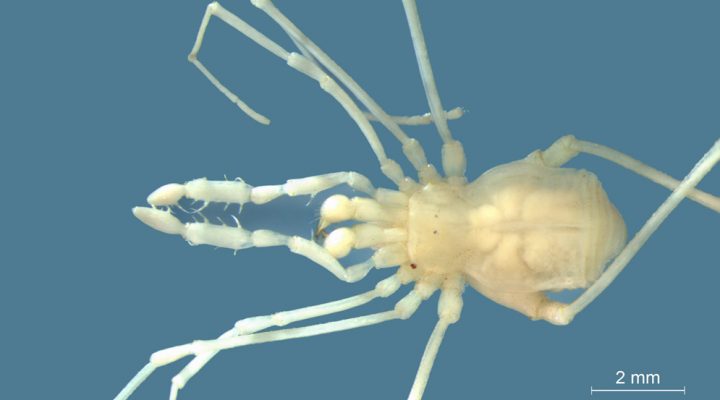BIOLOGICAL AND HEALTH SCIENCES
Scientists discover a new species of arachnids in a cave in Mendoza
It is an exclusively caveman taxon that belongs to a family so far unknown of Opilion Order.
Opiliones are a frequent order of arachnids in humid areas. In Argentina, it is very common to find them in the Pampas, Mesopotamia or in Yungas regions but not common –or almost impossible- to find them in the middle of aridity of the Puna, Cuyo or Patagonia. However, occasionally, in very dry contexts, isolated spaces with microclimates of higher humidity are preserved. These places allow the persistence -in the form of relics- of species typical of a time when the climatic conditions of the region were more benign and probably, the fauna question was more widespread.
Luis E. Acosta, CONICET researcher at the Instituto de Diversidad y Biología Animal (IDEA, CONICET-UNC), has recently described and classified from a taxonomic point of view, a new species of opilion found in the basaltic region of Payunia (South of the province of Mendoza), in a volcanic cavern of more than eight hundred meters known as Doña Otilia. The first specimens were found by Marcela Peralta, reseracher of the Fundación Miguel Lillo, who sent the material to Acosta for analysis. As a tribute the new taxon was baptized as Otilioleptes marcelae. The study was published in Plos One.
“Doña Otilia is an extensive lava tube surrounded by a semi-desert epigean environment in which it would be impossible for any opile to survive. Nevertheless, int the subsoil runs water from thaws, which manages to seep through cracks in the cave and maintain high levels of humidity – about eighty per cent- inside it,” Acosta explains.
Through the morphological analysis of specimens of both sexes, Acosta realized that it was an exclusively caveman species (troglobia), that is, that it develops its entire life within the limits of the cave. As in other cases of obliged cavemen, Otilioleptes marcelae shows a series of morphological characteristics that correlate with the hypogeal life known as troglomorphisms.
“Some of these distinctive features are the lengthening of the appeandages –apparently this is because of a sensory need in the Framework of the total darkness in which they live – a weaker tegument, strong reduction of the eyes- we are still not sure if they can see something probably not –and depigmentation,” says the researcher.
Otilioleptes marcelae is the second troglobio opilion reported in Argentina (the first was Picunchenops spelaeus, found in a karst cave in the province of Neuquén) and the first found in a lava tube in South America.
On the other hand, the cladistic or phylogenetic analysis, based on a comparative morphological study, allowed us to establish that Otilioleptes marcelae not only represents a new species and genus but also that I would belong to a new family of opilions, which Acosta called Otilioleptidae.
“Due to its genital morphology, we knew that O. marcelae belonged to the superfamily of the Gonileptoids, and at first I thought it could be from the Gonilipeptide family, which is the most common in Argentina but the cladistic analyses showed that it belonged to a more primitive group in the evolutionary history of Gonyleptoidea,” affirms Acosta, who placed the new species in a basal place within the Clamina Laminata, an internal lineage of Gonileptoids.
Finally, the researcher highlights the evolutionary importance of this troglobe, as well as its potential vulnerability and the urgent need to establish protection measures for the Doña Otilia cavern, which is currently not within any protected area.
By Miguel Faigón
References
Acosta, L. E. (2019). A relictual troglomorphic harvestman discovered in a volcanic cave of western Argentina: Otilioleptes marcelae, new genus, new species, and Otilioleptidae, new family (Arachnida, Opiliones, Gonyleptoidea). PloS one, 14(10), e0223828 https://doi.org/10.1371/journal.pone.0223828
About the study:
Luis E. Acosta. Independent researcher. IDEA.
